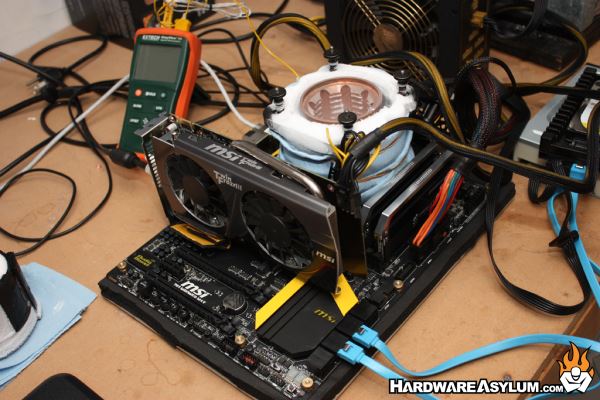MSI Z87 MPower Max Overclocking Impressions
Author: Dennis Garcia
Published: Monday, August 05, 2013
Conclusion
The MSI Z87 MPower Max is what I would call a midrange overclocking motherboard designed for power users looking to build a solid computing platform. Given the overall feature set of the MPower Max the motherboard would feel right at home in a high-end gaming rig or under cold on a LN2 test bench.
Overclocking the Z87 MPower Max was about as easy as you would expect. The start was a little rocky until I figured out what temps and voltages my processor needed to complete the various benchmarks. After that everything just worked. The motherboard also responded to system crashes quite well but would sometimes get hung up when changing memory timings. A quick CMOS reset allowed the system to boot though I would have much preferred the option to change what failed without having to load a saved profile.
Sadly, my processor turned out to be rather "junky" but I was able to get some good scores. SuperPi 32m was run at 5.8Ghz followed by Cinebnech at 5.5Ghz. Given that BCLK adjustments aren't supported on any of the MSI Z87 motherboards all of the overclocking was done with straight multiplier adjustments from the UEFI and Command Center Lite.
Overclocking the Z87 MPower Max was about as easy as you would expect. The start was a little rocky until I figured out what temps and voltages my processor needed to complete the various benchmarks. After that everything just worked. The motherboard also responded to system crashes quite well but would sometimes get hung up when changing memory timings. A quick CMOS reset allowed the system to boot though I would have much preferred the option to change what failed without having to load a saved profile.
Sadly, my processor turned out to be rather "junky" but I was able to get some good scores. SuperPi 32m was run at 5.8Ghz followed by Cinebnech at 5.5Ghz. Given that BCLK adjustments aren't supported on any of the MSI Z87 motherboards all of the overclocking was done with straight multiplier adjustments from the UEFI and Command Center Lite.

I did find it a little cumbersome to insulate around the massive "M" PWM cooler and while my CPU container did fit my concern was that my armaflex insulation wouldn't create a good seal around the CPU. Clearance was tight but, I'm happy to say that everything worked out nicely.
Overall I found the MPower Max to be a very capable motherboard, the layout is quite good and follows a typical dual GPU layout with support for a third card for 3-way Crossfire or dedicated PhysX. There is a handy mSATA connection between the video card slots which can be used for SSD Caching or as a standalone drive for benchmark runs.
There were a few issues worth mentioning. The first is memory support, during my benchmark runs I started out using GSKill TridenX modules clocked in at 2666Mhz and no matter what I changed I couldn't adjust the timings beyond what came configured in XMP. I later switched to Corsair Dominator 2133Mhz modules and were able to adjust timings and frequency leading me to believe there was a simple lack of support for the higher speed modules.
I was also rather disappointed in the UEFI implementation. The main menus are clearly marked but finding options inside those menus took awhile. Having navigated an MSI BIOS before I knew what to expect however the lack of breadcrumb trails indicating where you are was quite annoying. Along the same lines, the deeper you go the fewer descriptions you get so keep a secondary system handy for google searches. Granted most of the sub menus are for advanced users but, very few of us have electrical engineers on Skype for questions and answers.
Overall I found the MPower Max to be a very capable motherboard, the layout is quite good and follows a typical dual GPU layout with support for a third card for 3-way Crossfire or dedicated PhysX. There is a handy mSATA connection between the video card slots which can be used for SSD Caching or as a standalone drive for benchmark runs.
There were a few issues worth mentioning. The first is memory support, during my benchmark runs I started out using GSKill TridenX modules clocked in at 2666Mhz and no matter what I changed I couldn't adjust the timings beyond what came configured in XMP. I later switched to Corsair Dominator 2133Mhz modules and were able to adjust timings and frequency leading me to believe there was a simple lack of support for the higher speed modules.
I was also rather disappointed in the UEFI implementation. The main menus are clearly marked but finding options inside those menus took awhile. Having navigated an MSI BIOS before I knew what to expect however the lack of breadcrumb trails indicating where you are was quite annoying. Along the same lines, the deeper you go the fewer descriptions you get so keep a secondary system handy for google searches. Granted most of the sub menus are for advanced users but, very few of us have electrical engineers on Skype for questions and answers.
Good Things
Good Layout for Supercooling
Large 20-Phase PWM
Killer Nic e2200
Sound Blaster Cinema
Gold Plated Audio Sockets
Separated Audio Electronics
Benchtop Controls
Large 20-Phase PWM
Killer Nic e2200
Sound Blaster Cinema
Gold Plated Audio Sockets
Separated Audio Electronics
Benchtop Controls
Bad Things
Location of cpu voltage test points
Lack of BCLK adjustments
Getting lost in the UEFI menus
Lack of BCLK adjustments
Getting lost in the UEFI menus

